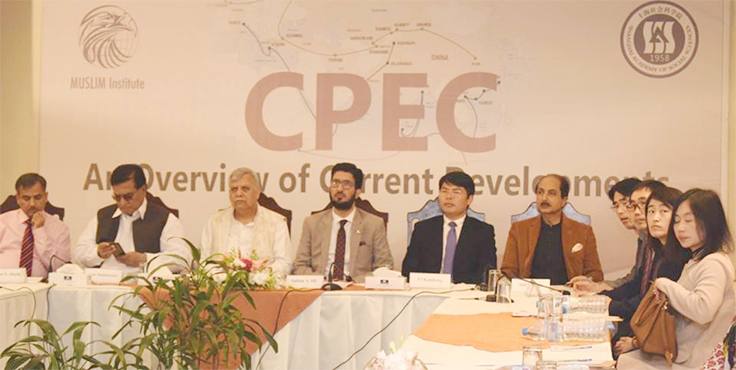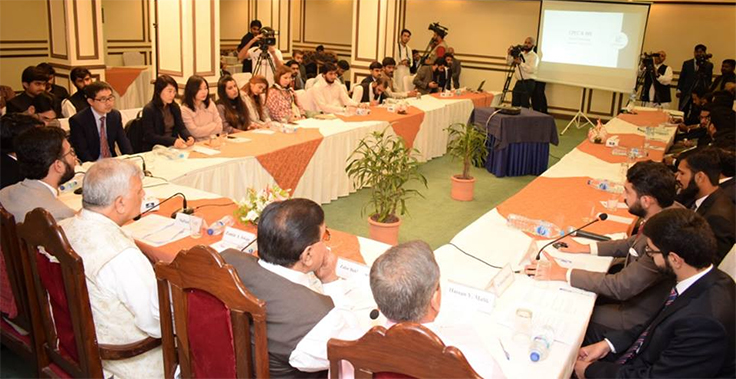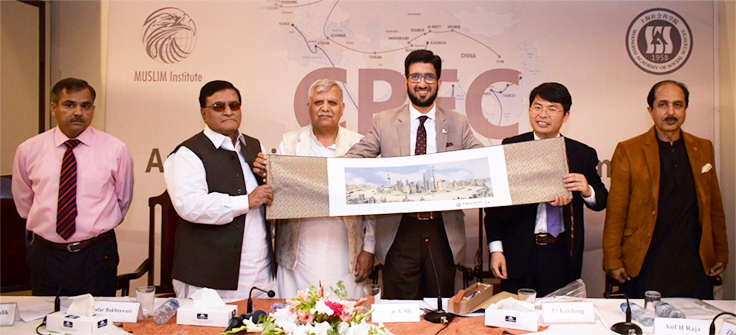| |
|
|
Seminar on
CPEC: An Overview of Current Developments
Organised By MUSLIM Institute
April 19, 2019
|
|






|
|
Prof. Zamir Ahmed Awan (National University of Science & Technology (NUST) Islamabad) chaired the session. Sahibzada Sultan Ahmad Ali (Chairman MUSLIM Institute) delivered the opening remarks. Mr. M. Hamza Iftikhar (Research Associate, MUSLIM Institute) moderated the proceedings. Diplomats, Scholars, Academics and Policy Makers participated in the seminar.
|
Honourable Speakers
|
»
|
Dr. Li Kaisheng
Deputy Director, Institute of International Relations, Shanghai Academy of Social Sciences, China
|
|
|
»
|
Mr. Zafar Bakhtavri
Former President, Islamabad Chamber of Commerce
|
|
|
»
|
Brig. (R) Asif Haroon Raja
Defense Analyst
|
|
|
»
|
Dr. Hassan Yaser Malik
Chartered Member of Institute of Logistics & Transportation, UK
|
|
|
»
|
Dr. Zhang Yifeng
Shanghai Academy of Social Sciences, China
|
|
|
»
|
Mr. Usama Bin Ashraf
Research Associate, MUSLIM Institute
|
|
|
|
Brief summary of the Remarks shared by the speaker is observed as following:
In today’s increasingly realist world, where relations between states are shaped by the principles of realpolitik, regional cooperation is gradually becoming the need of time. Countries with a strong level of mutual understanding and policies for shared prosperity are benefiting greatly as opposed to those who choose a more isolationist path. Trade and economic cooperation, in the backdrop of the contemporary geopolitical environment, hence, has become one of the most important aspects in global affairs. In such an environment, Pakistan and china proudly enjoy historically rich and friendly relationship since 1950s. This relationship reached new heights with the launching of Belt and Road Initiative (BRI) in 2013 and its flagship and pilot project China Pakistan Economic Corridor (CPEC). It is the geographical and economic significance of CPEC that has attracted other regional as well as global economies to take keen interest in Pakistan, thereby opening the way for Pakistan to have the opportunity to become an economic and trade hub for the region. A reflection of this can be seen in the forecast of PWC – an international auditing firm – which predicts Pakistan to be the 20th largest economy of the world by 2030.
|
|
|

From left:
Dr. Hassan Yaser Malik,
Mr. Zafar Bakhtavri,
Prof. Zamir Ahmed Awan,
Sahibzada Sultan Ahmad Ali,
Dr. Li Kaisheng,
Brig. Asif Haroon Raja (R)
|
|
Asia remains at the epicentre of 21st century transformation as the centre of economic power is shifting from the West towards the East. Belt and Road Initiative (BRI) provides Pakistan and the surrounding countries great opportunity by giving an integrating platform for over 3 Billion people in Central Asia, Western Asia, South Asia as well as Middle East and Africa. CPEC is the cornerstone of Belt and Road Initiative (BRI) and rooted in the Silk Road spirit of peace, cooperation, openness, inclusiveness and mutual benefit. BRI enters terrain that few other initiatives are willing to step into, and leaves behind a trail of new roads, rail lines, bridges and power plants. One of the primary goals of the initiative is to use the economic prowess of developed markets like China to prop-up and assist under-developed markets through their transition to a more secure economy. Total Trade in BRI countries has been estimated between $1 Trillion - $2 Trillion in 2014-2016. Chinese Investment in BRI Countries is estimated to have reached $50 Billion till date. BRI covers 65 Countries with 30% of World’s GDP and 62% of World’s Population. 56 Economic Zones are being planned to be built in BRI countries with $18.5 Billion investment and estimated relocation of 85 Million jobs.
CPEC includes three Development Phases:
Phase I (2020): Period of market cultivation, major bottlenecks to Pakistan’s economic and social development addressed to boost the economic growth.
Phase II (2025): Period of expansion and development. Processing and manufacturing industries, agriculture sector and tourism to be developed, significant improvement in the people’s livelihood, balanced regional economic development.
Phase III (2030): Period of Maturity. The endogenous mechanism for sustainable economic growth will be in place, CPEC ready to play leadership role in the region.
|
|
|
CPEC is a multi-dimensional project and beside connectivity it will boost economic growth of Pakistan and by ensuring energy security (new power plants), Special Economic Zones (SEZs), human resource development, national integration/regional linkages, technological innovations. CPEC being part of Silk Route provides China a safe, economical and sustainable corridor for its industry’s hydrocarbon needs. Moreover, through Gwadar, China can cut-short thousands of miles of maritime routes for its exports.
In the 14th century the sea levels communication in the Pacific region became more prominent, which highlights the value of blue economy. Globalization of trade, advances in communication and faster means of transportation, also re-invigorated the blue economy. Cardinals of the blue economy proves to be true that “seas unite and land divides”. The high seas are common heritage of all nations thus rejuvenate the diplomacy. Today 95% of world trade is carried out in the seas. Economy is the strongest rule of diplomacy in the present era. Economy is dependent on adequate transportation of hydrocarbons. The blue economy is dependent on the land as well. Ambitious project of CPEC will provide a corridor between East Asia, South Asia, Central Asia and most importantly the Arabian Sea via Gwadar thus revolutionizing the blue economy. Gwadar is a pivotal linkage between intercontinental trade routes and the maritime sea. By linking Western China and Pakistan to the world’s oceans, CPEC has truly become a gateway to prosperity.
|
|
|

Hall view during the seminar.
|
|
China described the CPEC as a flagship project of product policy, Belt and Road Initiative (BRI), which seeks to physically connect Asia, Africa, Europe and beyond, through policy of peace and shared benefits. The New Silk Road will link China with Europe, Central Asia and America itself to ensure a safe passage of China's shipping through Indian Ocean and the South China Sea. CPEC could be opportunity for regional peace. No peace and security mean no development and vice-versa. This challenge is being faced in Asia which is very important region not only for Pakistan but also for China.
|
|
|
Given the holistic economic benefits of CPEC to the country, it has been welcomed by the people of Pakistan. In the last couple of decades, Pakistan has been through some of the harshest times where people have sacrificed a lot over the years. With the efforts and dedication of the whole nation, we have achieved peace in the country. This is hence an appropriate time that we benefit from CPEC and ensure the long-neglected development that Pakistan has longed for.
|
|
|

Stage and participants during the seminar.
|
|
CPEC not only serves as a magnet for investment from abroad, but also serves as an enabler for maximising Pakistan’s local production and boosting its domestic industries which will benefit by having a direct and economically viable gateway to international market via Gwadar – which in itself is a natural asset of Pakistan that Allah All Mighty has bestowed upon Pakistan.
|
|
|

Chairman Muslim Institute Sahibzada Sultan Ahmad Ali receiving memorabilia from Chinese delegation.
|
| |
|
|
|
|
|
| |
|